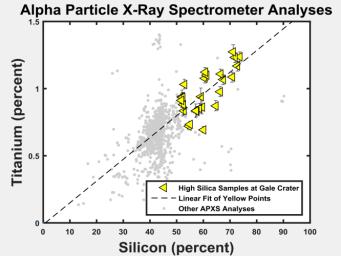
|
Silicon and Titanium Correlation in Selected Rocks at Gale Crater, Mars
- Click the image above for a larger view
- Full-Res JPEG (1730 x 1300) (163.3 kB)
- Full-Res TIFF (1730 x 1300) (384.0 kB)
Caption:
The yellow triangles on this graph indicate concentrations of the elements titanium and silicon in selected rock targets with high silica content analyzed by the Alpha Particle X-ray Spectrometer (APXS) instrument on NASA's Curiosity rover in Mars' Gale Crater.
The pattern shows a correlation between enriched silicon content and enriched titanium content. Titanium is difficult to mobilize in weathering environments, and this correlation suggests that both titanium and silicon remain as the residue of acidic weathering. Ongoing research aims to distinguish between that possible explanation for silicon enrichment and an alternative of mobilized silicon being added to the site (see PIA20275 ).
As a general comparison with these selected high-silica targets in Gale Crater, the gray dots in the graph show the range of titanium and silicon concentrations in all Martian targets analyzed by APXS instruments on three Mars rovers at three different areas of Mars.
Background Info:
NASA's Jet Propulsion Laboratory, a division of the California Institute of Technology, Pasadena, manages the Mars Science Laboratory Project for NASA's Science Mission Directorate, Washington. JPL designed and built the project's Curiosity rover.
More information about Curiosity is online at http://www.nasa.gov/msl and http://mars.jpl.nasa.gov/msl/ .
Cataloging Keywords:
| Name | Value | Additional Values |
|---|---|---|
| Target | Mars | Titan |
| System | Saturn | |
| Target Type | Planet | Satellite |
| Mission | Mars Science Laboratory (MSL) | |
| Instrument Host | Curiosity Rover | |
| Host Type | Rover | |
| Instrument | Alpha Particle X-Ray Spectrometer (APXS) | |
| Detector | ||
| Extra Keywords | Color, Crater | |
| Acquisition Date | ||
| Release Date | 2015-12-17 | |
| Date in Caption | ||
| Image Credit | NASA/JPL-Caltech/University of Guelph | |
| Source | photojournal.jpl.nasa.gov/catalog/PIA20274 | |
| Identifier | PIA20274 | |
